- Quick Read
- Deep Read ( 11 Min. )

Why is Christian Science in our name?
Our name is about honesty. The Monitor is owned by The Christian Science Church, and we’ve always been transparent about that.
The Church publishes the Monitor because it sees good journalism as vital to progress in the world. Since 1908, we’ve aimed “to injure no man, but to bless all mankind,” as our founder, Mary Baker Eddy, put it.
Here, you’ll find award-winning journalism not driven by commercial influences – a news organization that takes seriously its mission to uplift the world by seeking solutions and finding reasons for credible hope.
Explore values journalism About usIn Today’s Issue
- Biden poured money into public works. Will that help Harris in Michigan?
- Today’s news briefs
- With Russia at their door, Ukrainians flee Pokrovsk
- Massachusetts needs workers. Enter free community college.
- How does your money affect the elections? Four questions.
- In Toronto: One week, 20 movies, and Springsteen
Monitor Daily Podcast
- Follow us:
- Apple Podcasts
- Spotify
- RSS Feed
- Download
TODAY’S INTRO
A different lens on today’s problems
 Mark Sappenfield
Mark Sappenfield
Former Monitor Editor Marshall Ingwerson had a radical idea. Inside the newsroom and out, he would often ask: What works? The idea is that looking at successful solutions circumvents so much needless politics and rhetoric. He’s since gone on to found The What Works Initiative.
Today, Troy Aidan Sambajon does Marshall proud. Education is full of challenges. But Troy finds that new efforts to make community colleges affordable, even free, are making a difference. It’s a reminder of Marshall’s main point: There is a different way to look at today’s problems.
Share this article
Link copied.

Help fund Monitor journalism for $11/ month
Already a subscriber? Login

Monitor journalism changes lives because we open that too-small box that most people think they live in. We believe news can and should expand a sense of identity and possibility beyond narrow conventional expectations.
Our work isn't possible without your support.
Biden poured money into public works. Will that help Harris in Michigan?
Michigan is a top beneficiary of federal infrastructure funding, but there’s little sign it’s providing a political boost. Part of a series on the issues that may tip key swing states: Arizona, Georgia, Nevada, North Carolina, Pennsylvania, and Wisconsin.

-
Alfredo Sosa Staff photographer
As workers busily lay the groundwork for a new lock here in Sault Ste. Marie, Michigan, a poster on a nearby fence reads, “Project funded by President Joe Biden’s Bipartisan Infrastructure Law.”
The landmark 2021 legislation allocated roughly $1.2 trillion for roads, bridges, ports, water, and broadband across the United States – a historic surge of job-creating federal investment after decades of underfunding.
But the political payoff for Democrats – in Michigan and other swing states – may be close to nothing.
Despite the benefits to the economy and individual lives, these projects are long-term efforts. The new lock will take 10 years to complete. Meanwhile, the presidential election is less than two months away. And voters are more focused on inflation, which many economic experts agree this legislation contributed to but did not cause.
Since Mr. Biden withdrew from the race and Vice President Kamala Harris became the party’s presidential nominee, she has tried to cast herself as the “change” candidate, further complicating efforts to tout Biden-Harris achievements.
The infrastructure bill “would be a landmark achievement for any president, so your instinct is to campaign on it,” says Adie Tomer, a senior fellow at Brookings Metro. “But it runs head first into cold, hard political realities.”
Biden poured money into public works. Will that help Harris in Michigan?
The new lock has no name.
That will come later. For now, workers in orange vests excavate concrete and dirt from defunct locks built over a century ago in the St. Marys River that divides the United States and Canada. But when they are finished – and 1,000-foot long cargo ships laden with iron ore can rise and fall 20-plus feet in a matter of minutes – there will undoubtedly be a naming ceremony.
Maybe the Biden Lock?
As the “Project funded by President Joe Biden’s Bipartisan Infrastructure Law” poster tied to a nearby fence suggests, the new Soo Lock here in Sault Ste. Marie, Michigan, is spurred by the 2021 legislation that will be a cornerstone of Mr. Biden’s legacy.
Roughly $1.2 trillion is being allocated to projects across the U.S., including $700 million to the Soo Locks complex. It promises a historic surge of job-creating federal investment for roads, bridges, ports, water, and broadband after what experts say has been an era of chronic underfunding.
But the political payoff for Democrats – in Michigan and other critical swing states – may be close to nothing.
For all their tangible promise to the economy and individual lives, the projects funded by the Infrastructure Investment and Jobs Act (IIJA) are by nature long-term efforts. The new Soo Lock, for example, should be done within 10 years. Meanwhile, the election is less than two months away. What voters are more focused on is inflation, which many economic experts agree this legislation contributed to but did not cause.

The campaign politics around some of Democrats’ biggest legislative accomplishments have only gotten more difficult since Mr. Biden dropped out of the presidential race and Vice President Kamala Harris became the party’s presidential nominee. She has tried to cast herself as the “change” candidate, complicating efforts to tout Biden-Harris achievements – including the projects in their infrastructure and inflation reduction acts.
“These two bills would be a landmark achievement for any president, so your instinct is to campaign on it,” says Adie Tomer, a senior fellow at Brookings Metro and an expert on infrastructure policy. “But it runs head first into cold, hard political realities.”

Infrastructure has bipartisan support – to a degree
Infrastructure may be chronically underfunded by Washington, but it is one issue on which Americans on both sides of the political aisle find agreement. At least 70% of Republicans and more than 80% of Democrats favor funding for roads, bridges, and water pipes. (“Who likes lead in their water?” Mr. Tomer asks rhetorically.) When asked about the “Biden infrastructure plan” in a separate poll, however, fewer than 20% of Republicans approve.
With partisanship infiltrating all aspects of U.S. politics, infrastructure isn’t the unifying issue in Congress that it was almost a century ago. Mr. Biden and congressional Democrats, in wanting to signal they can work across the aisle, call the IIJA the “Bipartisan Infrastructure Law.” But while some Republican lawmakers supported it, a majority in both chambers voted against it.
Some of the Republicans who voted no have attended ribbon-cutting ceremonies for these projects, touting the benefits to their districts despite their previous opposition, to the ire of Democrats. And even when completed, these projects haven’t been universally embraced by all constituents.
In northern Michigan, Pellston Public Schools Superintendent Stephen Seelye heard that districts like his – rural, with high poverty and large Native American populations – prequalified for an electric school bus grant through the IIJA. He put in a request and was approved for four new buses late last year worth $375,000 each.
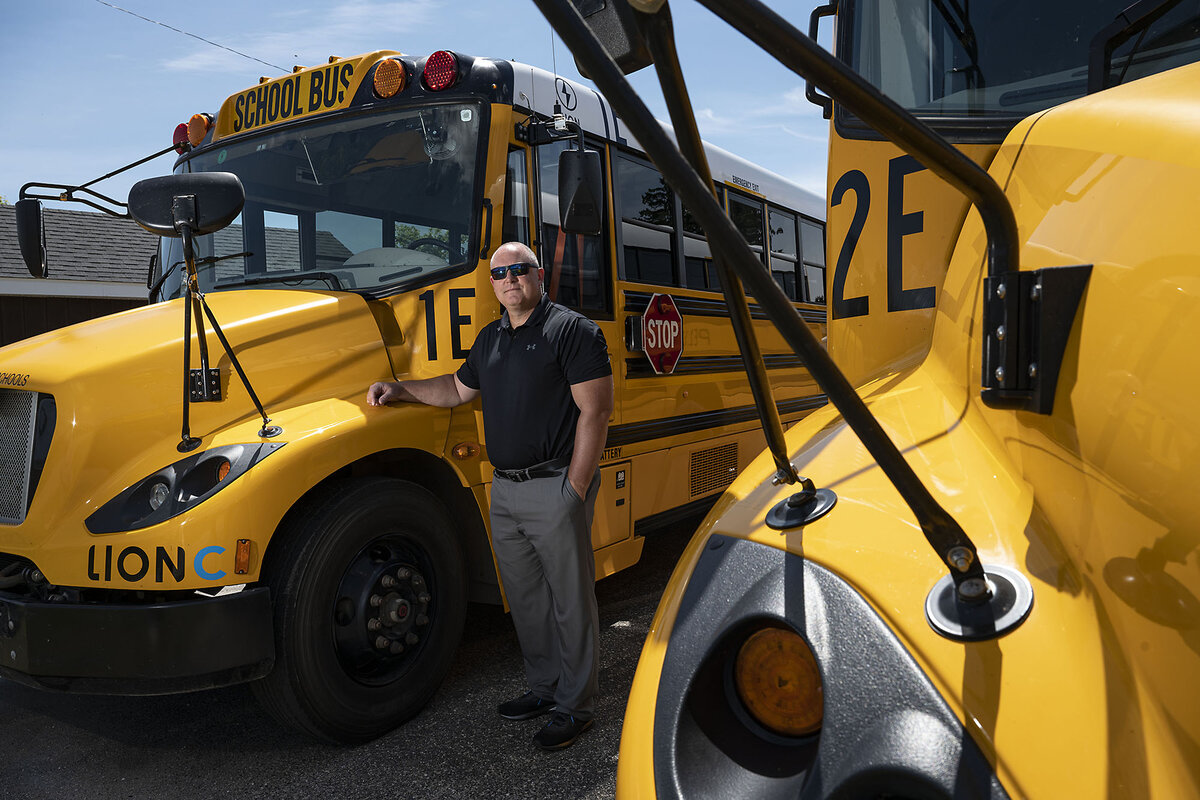
Pellston is one of almost 1,300 school districts in the U.S. that have been awarded almost 9,000 school buses through the Environmental Protection Agency’s Clean School Bus Program, a $5 billion slice of the IIJA.
Given that transportation costs per student are higher in rural districts, Pellston expects to save $50,000 a year as the electric buses reduce fuel and maintenance costs. For a district where 22% of children under 18 years old live in poverty, that kind of money is “huge,” says Mr. Seelye, as he leans against the hood of one of his new yellow buses, glittering in the afternoon sun. “That’s close to the cost of a teacher.”
But when the news was announced on Facebook, “the negative comments were crazy,” he says. “We’re in a very Republican area, so there was a lot of heat for putting these buses on the road.” He attributes the pushback from his community, where former President Donald Trump won by double digits, to the fact that “electric” has become a liberal buzzword, and that the source of funding is “a Biden thing.”
The criticism has died down now that Pellston has seen the buses in action, says Mr. Seelye. Drivers rave that their new vehicles handle the wintry roads far better, and they appreciate how the buses can be programmed to preheat ahead of time.
The district just got funds for its fifth and final bus to be traded for an electric one as well.
Without the federal funding, it would have taken a decade to replace the fleet. (The district was replacing one traditional school bus, each costing about one-third as much as an electric bus, every two years.)
In Kalamazoo, a faster road forward
Other local officials across Michigan say the IIJA cash influx is expediting projects that had previously been put off.
“The infrastructure bill has allowed us to do some catch-up and accelerate our work significantly,” says Dennis Randolph, a traffic engineer for the city of Kalamazoo, Michigan, about 250 miles south of Pellston.
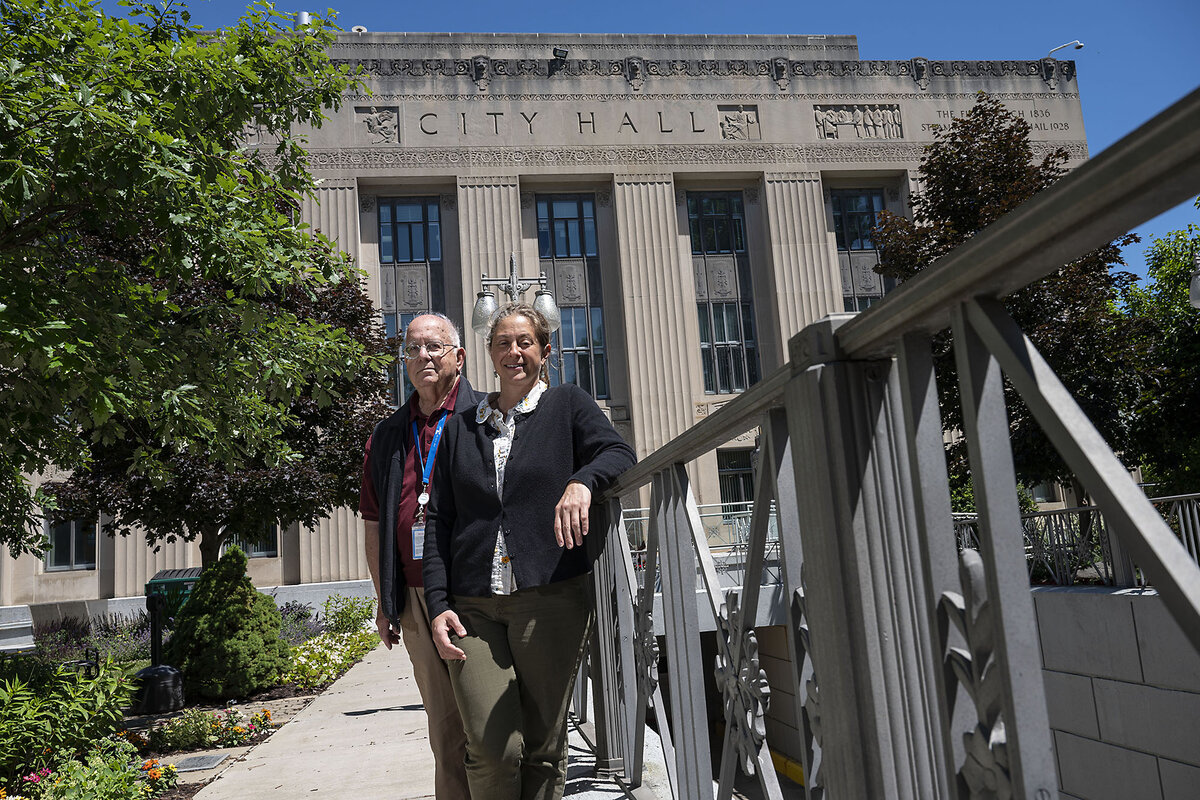
“And we’re also able to do the work better,” adds Kalamazoo city planner Christina Anderson.
Kalamazoo received over $12 million through the IIJA’s Reconnecting Communities and Neighborhoods Grant Program, which was created to redesign transportation systems that had cut through and disrupted minority neighborhoods in a form of racial discrimination. Two multilane, one-way roadways – Kalamazoo and Michigan avenues – are in the process of becoming two-lane streets with parking, bike paths, and pedestrian walkways.
As they drive around Kalamazoo in Mr. Randolph’s car, the two officials point out how the redesign will benefit the whole city. Locals in this majority Black neighborhood will be able to drive into town more easily without having to go in one-way circles, says Mr. Randolph. College students on the city’s west side will be able to safely cross the streets, says Ms. Anderson. A creekside walking path will be created near Michikal Street.
Without the IIJA funding, these projects would probably have taken Kalamazoo two decades to complete, says Mr. Randolph. Now they expect all of the work to be done by 2032.
But today, the city’s downtown is a mess of cones, detours, and angry drivers’ horns.
“Not only is infrastructure not always super sexy or flashy, but there is short-term pain associated with it,” says Ms. Anderson, gesturing to the “STREET CLOSED” signs in seemingly all directions.
“But there are also jobs associated with it, and material usage, and all sorts of other things that are positive for the economy,” she continues. “Which is why infrastructure often gets lifted up during times of economic challenge, and has forever in America’s history.”
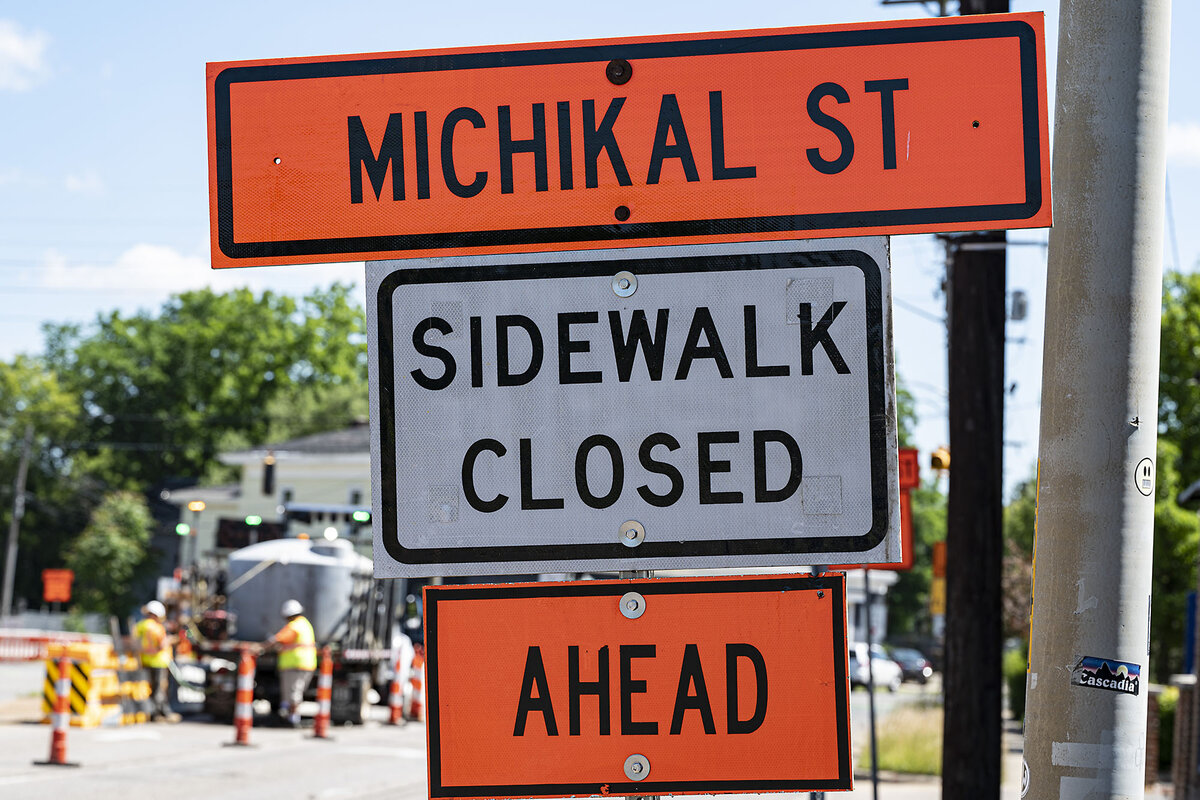
Rural broadband: echoes of the New Deal
Mr. Biden has invited comparisons between himself and President Franklin Roosevelt throughout his term, including in his State of the Union address earlier this year. The White House has compared the IIJA’s broadband program to the Rural Electrification Act, part of Mr. Roosevelt’s New Deal response to the Great Depression.
Michigan is getting one of the largest allocations from the IIJA’s Broadband Equity, Access, and Deployment program, which commits $42 billion to help homeowners who have been underserved by private providers because of their income or geography. The goal is to have all of America connected by 2030. But funding won’t reach specific projects until next year.
Another political challenge for Democrats: Voters often assume that things like smoother roads or better school buses are in the purview of local officials.
“Infrastructure is typically not a leading priority issue for voters, especially in a presidential [race],” says Mr. Tomer of Brookings Metro. A July survey from Gallup tracking top issues found that 33% of voters ranked economic issues as the most important issue facing the country, followed by “poor leadership” at 26%, and immigration at 19%. Infrastructure didn’t register in the poll, falling below 1 percentage point.
In many cases, these projects are seen as below the jurisdiction of statewide officials, which is partially what made Michigan Gov. Gretchen Whitmer’s winning gubernatorial campaign slogan in 2018 to “Fix the damn roads” so catchy.
But as Governor Whitmer soon found out, infrastructure projects can quickly become prohibitively expensive. Ms. Whitmer is now relying on IIJA funds to help fulfill her campaign promise. In turn, the IIJA’s conservative critics say such massive federal spending will inevitably involve waste, and burden the economy by adding to an already high federal debt.

In Michigan and beyond, maintenance deferred
Michigan is one of the top 10 states for IIJA funding – which makes sense, says Zachary Kolodin, director of the Michigan Infrastructure Office, given the state’s history. Between 1910 and 1960, Michigan’s population more than doubled, outpacing the overall U.S. growth rate. “Because that boom happened almost a century ago,” he says, “much of that infrastructure is considered aging.”
But here and in other U.S. states, repairs have been put off, because of price tags and the incentive for politicians to focus on immediate rather than long-term outcomes.
The collapse of Baltimore’s Francis Scott Key Bridge in March drew nationwide attention, for example, and although the collapse was caused by a collision involving a cargo ship, engineers say the bridge’s age played a role. According to the American Society of Civil Engineers, 46,000 U.S. bridges are “structurally deficient.” The society’s 2021 report card of American infrastructure (which gave the country a C-, its highest grade in 20 years) found that it would take until 2071 to make all of America’s necessary bridge repairs at the rate of investment prior to the IIJA.
Two days after the collapse, the Biden administration released a “down payment” (not from IIJA) to help with repairs.
“It’s been incredibly frustrating that we only think of infrastructure when it doesn’t work,” says Scott Berry, director of policy at the U.S. Water Alliance. “It’s truly difficult to quantify what a political success this bill is.”
How much good or harm for U.S. economy?
When the IIJA expires in 2026, whichever party wins control of Congress will decide how to fund these programs, or whether they will revert to previous funding levels.
So far less than half of the $1.2 trillion has been announced for specific projects. But the pace has picked up in recent months, as Biden officials know that designated funds are much more difficult to claw back if Republicans win majorities on Capitol Hill in November.
Some in the GOP have slammed the projects as inflationary, but the law’s true effect on inflation is “modest at best,” says Kent Smetters, an economics professor at The Wharton School of the University of Pennsylvania. He’s director of The Penn Wharton Budget Model, which estimates that the IIJA only added 0.1% to 0.2% to the current inflation rate.
That’s largely because the bill’s price tag isn’t actually $1.2 trillion, he adds. Only about half is really new funding; the rest is what the federal government would typically spend on infrastructure.
“This is one of those issues where the extremes on both sides are wrong,” says Professor Smetters, who doesn’t see the IIJA having a large negative or positive effect on the economy.

One factor: Some of these projects – like the new third lock at Sault Ste. Marie – were going to happen anyway. The new lock was first authorized by Congress in 1986, though construction didn’t actually begin until 2020. Now, the IIJA funding will allow the Army Corps of Engineers to “stay on schedule,” says Mollie Mahoney, senior project manager for the lock.
That’s important, because only two Soo Locks – the Poe and the MacArthur – are currently in operation. (Two other century-old locks were decommissioned in 2010.) The new lock will allow the Army Corps to take the Poe offline for repairs – a vital next step because the Poe is over its 50-year design life. Without the new, third lock, closing the Poe would halt 75% of U.S. steel production, according to a 2015 study by the Department of Homeland Security. “In terms of an impact to the North American economy, it is hard to conceive of a single asset more consequential than the Poe Lock,” concluded the report. Not to mention the impact such a closure would have on northern Michigan.
“Being federal employees, we look at things from a very national perspective,” says Rachel Miller, the new lock contracting officer’s representative. “But it’s also a central part of the community. In Sault Ste. Marie, the locks are the thing here.”
In the evening, horns sound as the MacArthur Lock opens its gates for the Algoma Discovery – a Canadian vessel carrying 25,000 tons of iron ore from Minnesota to Canada. After entering the lock at Lake Superior’s water level, the ship drops 1 foot per minute for 21 minutes, with the lock draining 22 million gallons of water to reach the level of Lake Huron.
As a Canadian employee on the top deck slowly falls to eye level, his eye catches my notebook. He asks what I am taking notes about, and I tell him I’m in Sault Ste. Marie to report on the new lock. The Canadian nods, saying he’s heard about it in his country, on the other side of the river.
“Wasn’t that a campaign promise from Trump?” he asks, before the boat blows its horn to exit the lock.
This is one of a seven-part series on key swing states in the U.S. presidential election and the issues that may tip them. The full series includes articles reported from Arizona, Georgia, Michigan, Nevada, North Carolina, Pennsylvania, and Wisconsin.

Today’s news briefs
• Georgia Trump case: The judge overseeing the Georgia election interference trial against Donald Trump and others tosses out three counts saying they are beyond the state’s jurisdiction.
• China fine on U.S. firm: Chinese authorities ban accounting firm PricewaterhouseCoopers for six months and fine it more than $56 million due to its involvement in the audit of collapsed local property developer Evergrande. The punishment is the heaviest yet for an international accounting firm operating in China.
• Unauthorized migration to Europe: Despite a summer of heated anti-immigration debates across the European Union, unauthorized migration to EU countries dropped significantly overall in the first eight months of this year.
• Boeing workers on strike: Aircraft assembly workers have walked off the job at Boeing factories near Seattle and elsewhere after union members voted overwhelmingly to reject a tentative contract that would have increased wages by 25% over four years.

With Russia at their door, Ukrainians flee Pokrovsk
The war in eastern Ukraine is creeping ever closer to Pokrovsk, a key logistics hub, forcing the city’s last civilian holdouts to make the hard choice to evacuate before Russian forces bring the fighting to their doorsteps.

- Quick Read
- Deep Read ( 6 Min. )
Pokrovsk once stood out as one of the livelier cities still under Ukrainian control in the contested eastern region of Donetsk. But now, the Russians are just under five miles from the southeast edge of the town, close enough to hit it with artillery. Over half of the district’s population of 54,000 has gone.
Police tallied 2,666 strikes within 24 hours from Sept. 10 to 11 across the region. Such numbers translate into a steady rumble of explosions and a rising casualty rate. July and August saw the highest monthly civilian death tolls since Russia’s full-scale war against Ukraine began in 2022.
Billboards now display one clear command: evacuate. Police cars patrol the few blocks that still show signs of life, reiterating the same message over their loudspeakers.
Roman Buhaiov, a volunteer with the East SOS charitable foundation, is determined to get as many people as possible to safety. The organization has five evacuation teams working nonstop to assist people with limited mobility.
“People always wait until the very last moment to evacuate,” says Mr. Buhaiov. “By the time they finally understand the danger of the war, it can be too late for the evacuation crews to help.”
With Russia at their door, Ukrainians flee Pokrovsk
Raisa Savchenko throws on her fur coat and makes one final, frantic survey of her apartment. She checks that the curtains are closed, the water valves shut, and the lights turned off. With her phone and documents packed and a wooden cane in hand, she walks gingerly down the stairs and climbs into an evacuation van.
“No one needs me here and nobody can look after me here,” says Ms. Savchenko, a retired post officer in her 80s, coming to terms with the uncertainty of her future as Russian forces continue to advance on her home in the eastern region of Donetsk. “I have nowhere to go.”
Safety is an elusive destination. But the evacuation of Ms. Savchenko and a bedridden neighbor from this mining town, in the Pokrovsk district of Donetsk, brings relief to their social worker.
“There are so many explosions now,” says Victoriia Kotyliak, who plans to leave as soon as the others in her care have left safely. “These ladies were all alone and becoming more and more anxious.”
That anxiety is understandable. Police tallied 2,666 strikes in 24 hours across the Donetsk region this week. Those numbers translate into a steady rumble of explosions and a rising casualty rate. July and August saw the highest monthly civilian death tolls since Russia’s full-scale war against Ukraine began in 2022.
Roman Buhaiov, a volunteer with the East SOS charitable foundation, is determined to get as many people as possible to safety. The nongovernmental organization has five evacuation teams working nonstop in Pokrovsk and the surrounding towns and villages. They prioritize people with limited mobility and form part of a broader safety blanket woven by Ukrainian volunteers all too familiar with crisis.
“People always wait until the very last moment to evacuate,” says Mr. Buhaiov, who started this line of work when he evacuated his own parents and relatives from Severodonetsk, which has been under Russian occupation since June 2022.
He checks that the teary grandmothers in his van have all they need, cracking jokes to put them at ease. “By the time they finally understand the danger of the war,” he says, “it can be too late for the evacuation crews to help.”
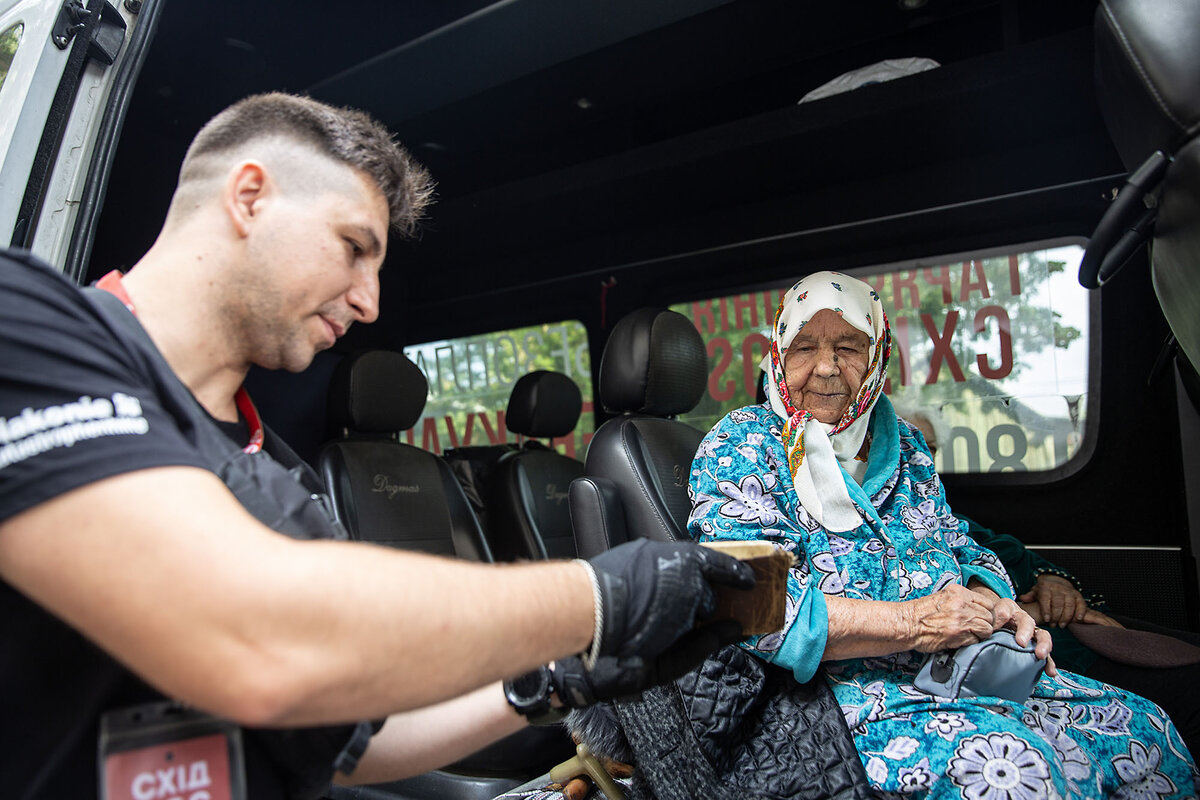
In Bilytske, even the pigeons are shell-shocked
Russian President Vladimir Putin has long coveted the industrial regions of Luhansk and Donetsk, collectively known as the Donbas, in eastern Ukraine. Russia seized control of large portions of these coal-rich areas in 2014 and has gradually expanded its territorial gains since its full-scale invasion in 2022. Last month, Russian forces broke through Ukrainian defense lines and rained destruction on residential towns, sparking a major civilian exodus.
Pokrovsk had stood out as one of the livelier cities still under Ukrainian control in Donetsk. But now, Russian forces are less than 5 miles from the southeastern edge of the town. This allows them to strike with artillery, as well as with “glide bombs” and missiles whose explosions are part of the soundscape. Over half of the district’s original population of 54,000 has gone.

Billboards that used to urge citizens to join various army units now display one clear command: evacuate. Police cars patrol the few blocks of Pokrovsk that still show signs of life, reiterating the same message over their loudspeakers. But time is running out. Evacuation trains no longer leave from the station, and the Russians have destroyed three of the road bridges that had offered a way out of the town.
Many of those who remain are too vulnerable to recognize the depth of the peril or too despondent to care. Others lack the means to leave. Some are deliberately staying, fueled by a potent cocktail of hope and defiance.
Many of those wandering the streets of Pokrovsk are in financial difficulty. Retirees ask each other where they can find a working ATM, so as to collect their pensions and buy food from the last few stores that remain open. Some even search trash cans for edible produce. Others try to sell vegetables and fruits from their gardens.
“Even the pigeons of the city are shell-shocked and disoriented,” says Lida, trying to sell homegrown tomatoes and grapes to finance her eventual departure.
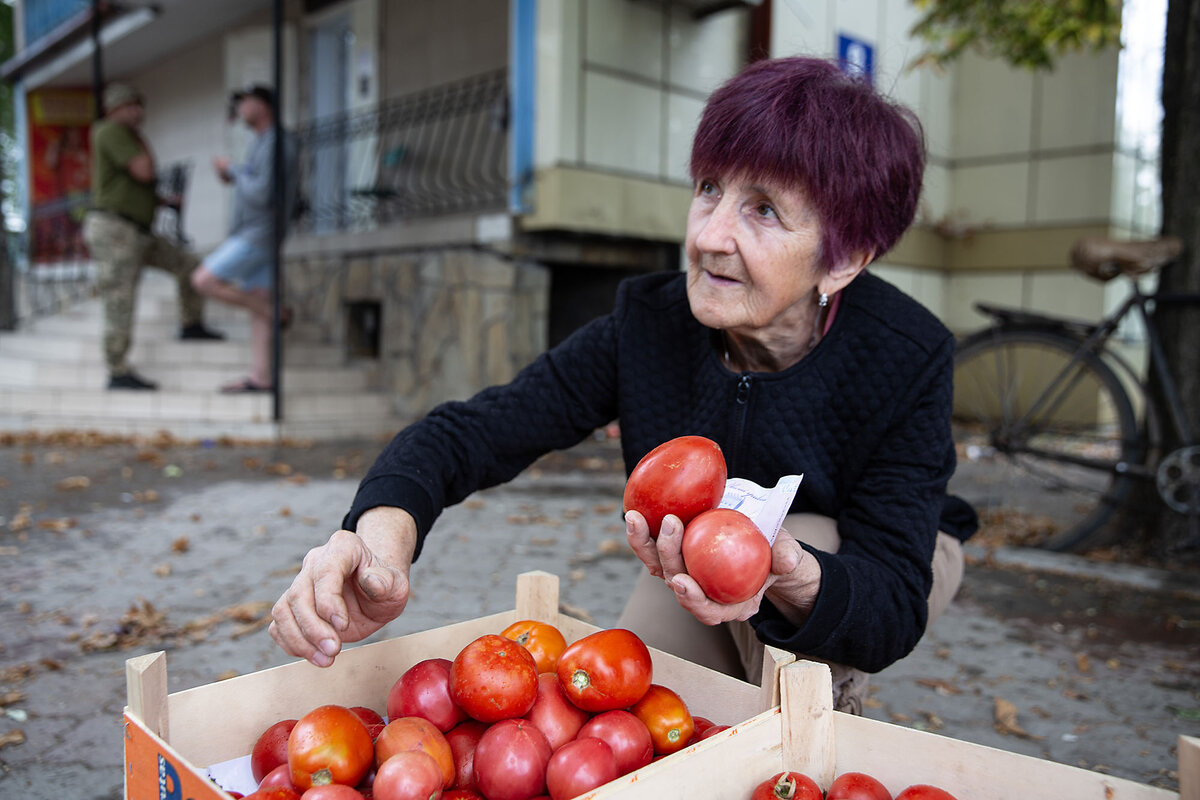
Curfew runs from 3 p.m. until 11 a.m., leaving only a short window for buying and selling food. Just one butcher shop remains open. Viktoriia Batrak, the owner, plans to continue operating as long as she can source pork from a nearby farm.
“I believe in our Ukrainian army,” says Ms. Batrak, who moved her daughter to the relative safety of western Ukraine. “But the Russian advance has been very fast. I am really scared they will take Pokrovsk.”
A dangerous situation turns critical
The future of the coal-rich Donetsk region of Ukraine appears increasingly uncertain. The Russian advance has slowed but not stopped this month. Russians have recently captured several villages to the south and east of Pokrovsk city, creating a patchwork of military gray zones, where Ukrainian civilians and evacuation teams are among the first to spot the arrival of Russian soldiers.
Russian troops have already reached the town of Selydove, just 9 miles south of Pokrovsk, according to locals. “Selydove is very dangerous now because Russian soldiers are roaming the streets,” says Anastasiia, waiting for an evacuation train in Pavlohrad because her home and entire street burned down after a Russian strike. “You can hear the gunfights.”
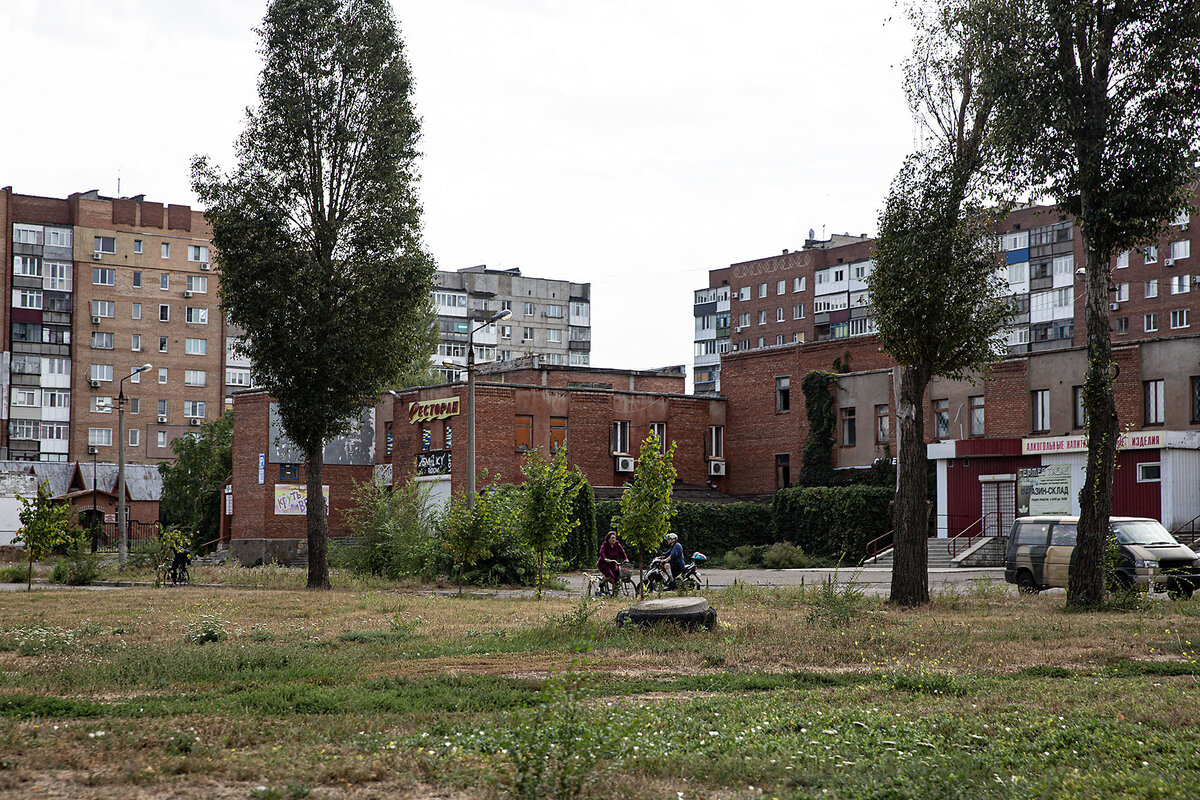
Oleksandr, a Ukrainian serviceman deployed with a combat unit says the town of Selydove is now the focal point of Russian offensive efforts in the Pokrovsk district. “They need to take over a town,” he explains. “They can’t just spend winter in the fields. The villages they have taken so far are so destroyed that they cannot sleep or set up positions there.”
But the ultimate prize would be the city of Pokrovsk, a key logistics hub, which Russian troops appear to be trying to surround from the east and south. “The Ukrainian units and weapons here should be enough to hold them off, but it all depends on what commanders decide,” says Oleksandr. “Dynamics can shift at any moment. They could encircle our forces and we could encircle their forces.”
The situation in the region is growing critical. On Thursday, 151 coal miners were trapped underground when a missile destroyed electricity transmission facilities in Dobropillya.

But still, some residents cling to the safety of the familiar even as the explosions get closer and louder, and municipal services like trash collection peter out.
“Who wants to abandon their own home?” asks Iryna, a teacher in Pokrovsk rushing home as news spreads by word of mouth that the city’s heating gas has been cut off.
Iryna still has electricity, she says, and her class still needs teaching, even remotely. So she is staying put. “There is no safe place in Ukraine. You never know where a [Russian] strike will meet you,” she says. “At least here you know every corner of your house and you know where to run and hide.”


Massachusetts needs workers. Enter free community college.
While the story of higher education has been one of ever-climbing costs, a sea change has been spreading at U.S. community colleges. When Massachusetts went tuition-free this fall, it wasn’t the first, or fifth, or even 15th state to do so.

- Quick Read
- Deep Read ( 6 Min. )
Klevans Lehens says he’s living proof that it’s never too late to go back to school.
Mr. Lehens, who is 45 years old and an EMT from Boston, opted to join the workforce to provide for his son instead of pursuing a degree. For the past two years, he’s been taking classes at Roxbury Community College.
He believes that making tuition free offers a second chance. “It’s a blessing for those who actually want to follow their dream. For me, it’s a sign I’m on the right path,” says Mr. Lehens.
This fall, Massachusetts is widening the halls of higher education. For the first time, all residents with a high school diploma can attend one of its 15 community colleges for free. Since Tennessee first pioneered tuition-free community college for all in 2017, it has spread rapidly. The reason: Economists say investing in public higher education yields better economic and social results than other types of workforce investments.
Mr. Lehens says he and his son are now attending college at the same time.
“That’s the beauty of life,” he says in the courtyard at Roxbury Community College. “You’re not always going to get it the first time, but you can always try again.”
Massachusetts needs workers. Enter free community college.

Cambridge resident Tyrie Daniel was almost at the finish line when he dropped out of Bunker Hill Community College in 2015.
He just needed 16 more credits to transfer to a four-year school. But life just came hard. His family was scammed, he says, and their Social Security numbers were stolen.
“When your stomach keeps growling and you have nothing in your fridge, you can’t even focus on school,” says Mr. Daniel, who is 33 years old. His family was struggling to pay bills at home and provide for their household of six.
The family needed an extra hand. And at the time, he says, “the extra hand was me. So I had to choose between school or food on the table.”
With five classes to go, he dropped out. He worked as a cleaner, in his family’s spice business, and in real estate. More than thrice, he contemplated returning to school. But he couldn’t reenroll until his overdue fees were paid.
Now, Mr. Daniel is back at Bunker Hill. This time, he is debt-free and his tuition is covered by MassReconnect. The program, which started in 2023, made community college tuition free for Massachusetts residents over 25 who don’t have a degree. Mr. Daniel says he feels both enormous relief and a new motivation to succeed.
“One of the huge benefits of MassReconnect for me is not having that financial pressure,” says the cybersecurity major. “Now, I’m actually back in school to further my career in something that I really am interested in and passionate about.”
This fall, Massachusetts is widening the halls of higher education even further. For the first time, all residents with a high school diploma can attend one of its 15 community colleges for free. Since Tennessee first pioneered tuition-free community college for all in 2017, it has spread rapidly in both red and blue states.
With the launch of MassEducate, the Bay State becomes the 20th to offer tuition-free community college regardless of age, income, or GPA. Another 14 states offer programs targeting specific demographics, such as people over 25, or high-demand majors, such as nursing.
“When we invest in institutions, in schools and colleges, that pays off in the long run. The cost-benefit ratio, for the individual and the society, is always positive,” says Douglas Harris, chair of the economics department at Tulane University and director of the National Center for Research on Education, Access, and Choice.
Professor Harris says promising universal access to community college “wipes away that complexity and the risk and uncertainty that goes with it.”
“Going to college is complicated,” he says. “When people come up against complicated, expensive decisions, they tend to say no. With free community college, you’re sort of reversing it. When it gets cheaper and simpler, it makes people say yes.”
When states started making community college tuition free, enrollment jumped by 10% and degree completion by 11%, according to a 2020 study by the Federal Trade Commission.
“This is going to change family trees for generations to come, for the better,” says Nate Mackinnon, executive director of the Massachusetts Association of Community Colleges.
It’s also coming at a time when sticker shock for four-year schools has never been greater, with tuition alone at institutions such as Northeastern University and Boston University topping $64,000 and $66,000 a year, respectively.
“As the cost of higher education rises, more families cannot afford private colleges,” says Mr. Mackinnon. “More families are turning to public higher education and discovering that these institutions offer excellent quality at an affordable price.”
Why free tuition now? The Bay State needs workers. Massachusetts has 42 available workers for every 100 open jobs, categorizing its workforce shortage as “most severe,” according to the U.S. Chamber of Commerce. Meanwhile, 700,000 residents have some college credits but no degree.
“The shape of the labor force is different and the need for training is strong,” says Pam Eddinger, president of Bunker Hill Community College. “When you think about how you provide an on-ramp for the next generation of workers in this Commonwealth, we are the linchpin.”
In MassReconnect’s first year, 2023-24, some 8,411 students enrolled through MassReconnect. That was a 45% increase in students over 25 from the previous academic year. Overall, the program reversed a decadelong decline in the state’s community college system – bumping enrollment up 9% in one year.
As of this August, with the launch of MassEducate, total enrollment is up another 20% compared with last year.
“It’s like the advertising value of free college is giving you a pretty big bang for your buck,” says David Deming, an economist from the Harvard Kennedy School whose research focuses on higher education and the future of the labor market.
The programs are considered “last dollar scholarships,” meaning they are applied after federal aid reduces tuition and fees for most students.
The challenge in the long term is maintaining the quality of education with more students. “If local colleges themselves are not getting any extra funding to accommodate the influx, the quality of the service itself might decline if the same resources are more thinly [spread] over more students,” says Professor Deming.
“Money was a big concern”
For recent high school graduates like Erick Peguero, free tuition means his family can save money while he takes classes in the hopes of transferring to a four-year program.
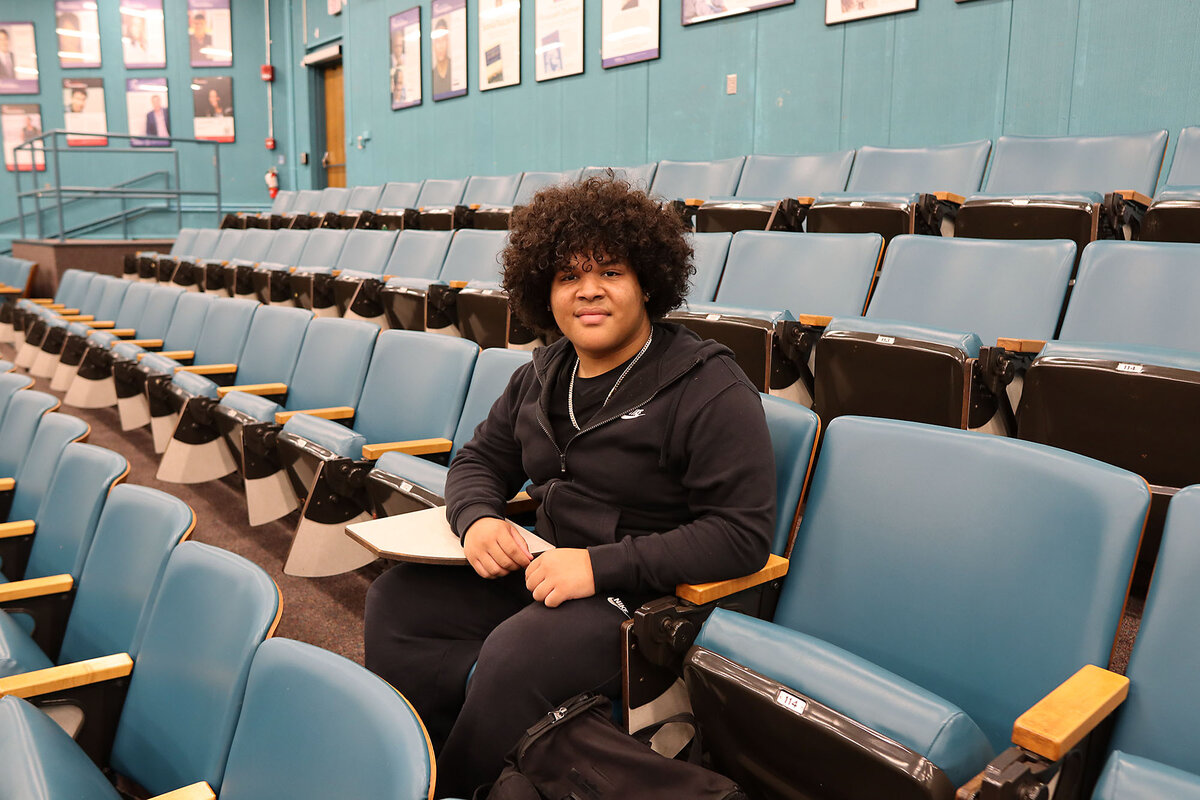
“Money was a big concern going into college, and I was considering a gap year,” says Mr. Peguero as he signs up for classes at Bunker Hill Community College on a recent August morning. His sister is already attending the University of Massachusetts Boston.
When he graduated from Brooke High School in June, Mr. Peguero didn’t have plans to go to college this fall. It wasn’t that the resident of the Dorchester neighborhood wasn’t interested, but his family lives in Section 8 low-income housing. When community college became free last month, he jumped at the chance to continue his education.
“I want to set myself up where I can have a future in four years. So this is definitely a huge opportunity for me,” says Mr. Peguero. The high school MVP plans to study electrical engineering and play baseball for the Bunker Hill Bulldogs.
The state set aside $117 million in the budget for MassEducate to build on MassReconnect. Both programs are funded by the “millionaires’ tax,” a 4% surtax on incomes over a million dollars.
“This will open up doors for so many more students,” says Mr. Mackinnon. “But at the same time, there’s a bit of trepidation about how we’ll handle all the students coming through the door.”
Will more students mean more resources?
Klevans Lehens, 45, says he’s living proof that it’s never too late to go back to school.
In the early 2000s, Mr. Lehens, an EMT from Boston, opted to join the workforce to provide for his son instead of pursuing a degree. For the past two years, he’s been taking classes at Roxbury Community College (RCC).
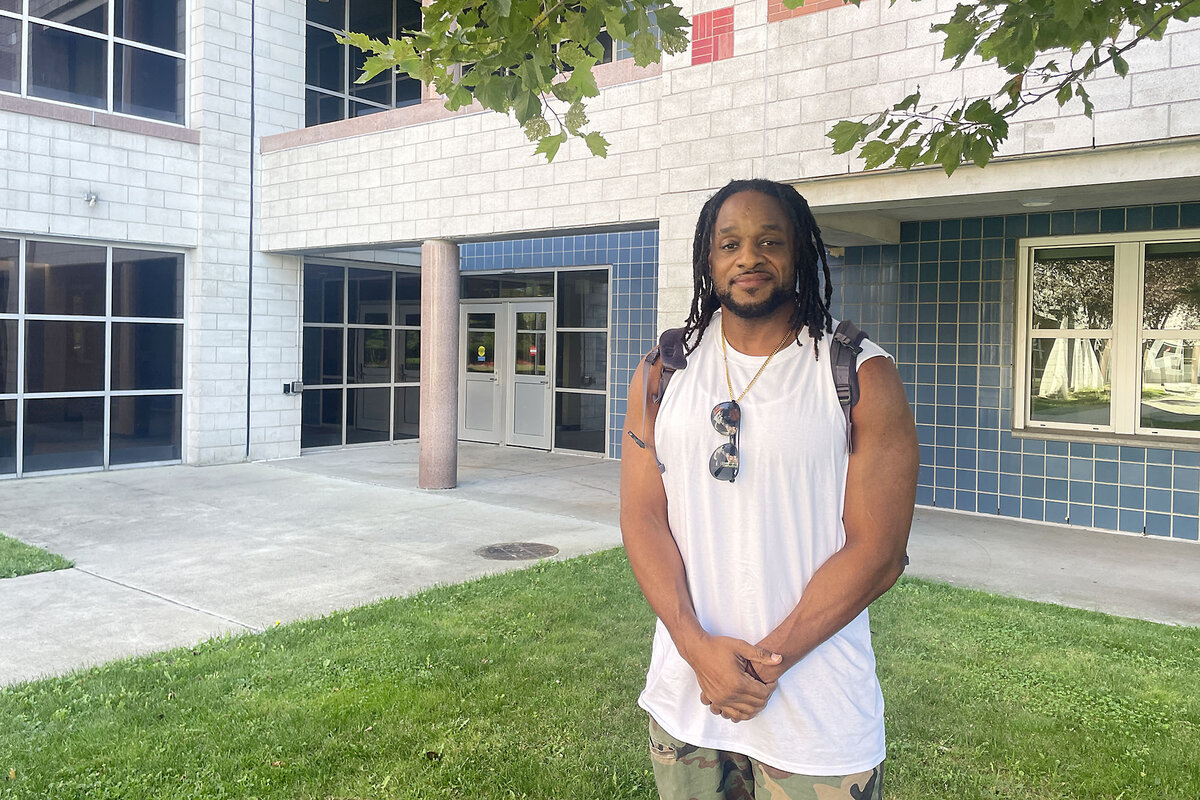
He believes that making tuition free offers a second chance. “It’s a blessing for those who actually want to follow their dream. For me, it’s a sign I’m on the right path,” says Mr. Lehens.
He says he and his son are now attending college at the same time – his son has a full ride scholarship to a Florida university.
“That’s the beauty of life,” says Mr. Lehens in the courtyard at RCC. “You’re not always going to get it the first time, but you can always try again.”
At Roxbury, the recent surge in enrollment is expected to strain existing resources aimed at supporting students. RCC has on-campus wellness programs, tutoring programs, a food pantry, and an emergency gap fund to help students cover basic needs. Other community colleges also provide child care services.
“Providing support beyond the classroom is key to improving student retention and completion,” says Luciano Ramos, executive director of the Center for Economic and Social Justice at RCC. “We’re committed to offering programs and innovations that support our students holistically.”
It’s unclear if these services – which are expected to see increased demand – will receive more funding. Mr. Mackinnon also is concerned about instructors’ salaries.
“You can get a better starting salary as a high school teacher in most cities and towns in the commonwealth,” he says.
But some community college leaders say they welcome the challenges that more students in classes bring.
“I’ve been waiting my entire professional life for this moment,” says Ms. Eddinger. “I’ll be damned if I’m going to turn anyone away. Because if I turn somebody away now, where it takes so much for them to come to me, they may not come back.”

How does your money affect the elections? Four questions.
In politics, money really does talk. Campaign donations are a form of protected free speech, with the current election on track for record spending. And small donors are a rising force.

- Quick Read
- Deep Read ( 4 Min. )
The current election is on track to bust through past records to become easily the most expensive presidential race in the United States’ history.
In part, this continues an ever-rising trend line, after a 2020 race that, at $6.5 billion, more than doubled the 2016 fundraising total. On both sides, there is a sense of near-existential stakes for the nation’s future, engaging donors from billionaires to bake-sale volunteers.
Both teams have stressed the importance of small donors, often considered a grassroots indicator of excitement about a candidate. The money is used for everything from staff salaries to voter outreach and advertising.
In the past five presidential elections, all winning candidates raised significantly more money than their opponents – except when Hillary Clinton lost to Donald Trump in 2016, despite her $230 million fundraising advantage. In the 2020 Democratic primaries, candidate Michael Bloomberg spent over $1 billion of his own cash, to little avail.
When it comes to the current presidential election, “What’s important is that both candidates have enough money to do what they feel that they need to do,” says Michael S. Kang, a law professor at Northwestern University. “Not so much that they have more than the other side.”
How does your money affect the elections? Four questions.

The current election is on track to bust through past records to become easily the most expensive presidential race in the United States’ history.
In part, this continues an ever-rising trend line, after a 2020 race that, at $6.5 billion, more than doubled the 2016 fundraising total. On both sides, there is a sense of near-existential stakes for the nation’s future, engaging donors from billionaires to bake-sale volunteers.
The late-stage arrival of Kamala Harris as the Democratic nominee created its own money boost. Surging enthusiasm helped her campaign reverse the fundraising lead that Donald Trump enjoyed before President Joe Biden exited the race.
Both teams have stressed the importance of small donors, often considered a grassroots indicator of excitement about a candidate. Yet how much of an impact that money will make is up for debate, and it remains only a fraction of the amount being moved by wealthy donors.
How did elections draw such record amounts of money?
To observers in other wealthy democracies, where elections are generally publicly funded, it may look like things have gotten out of hand. In the U.S., it comes down to the First Amendment.
Over 7 in 10 Americans say there should be limits on how much individuals and organizations can spend on political campaigns. And there are some constraints in federal law, such as a $3,300 cap on what an individual may donate to a candidate’s campaign committee.
But Supreme Court rulings have determined that any limits on overall spending by a campaign or political action committee would be an unconstitutional squeeze on free speech rights. And that wealthy individuals can donate unlimited amounts for outside (noncampaign) efforts to influence and mobilize voters.
One result of court rulings, such as Citizens United v. Federal Election Commission in 2010, is the rise of super PACs, political action committees that bring in gargantuan sums, mostly from a relative handful of rich donors.
“We have a much less regulated system than most developed democracies,” says Michael S. Kang, a law professor at Northwestern University. While that has ensured a robust arena of political expression, it has also raised concerns about whose voices ring loudest.
How much does campaign finance matter?
Funding can be especially important early on in a campaign, especially if a candidate lacks name recognition. And campaign spending tends to be more important for challengers than for incumbents, who are less likely to change voters’ minds. But money does not always mean success.
In the past five presidential elections, all winning candidates raised significantly more money than their opponents – except for one. Mr. Trump beat Hillary Clinton in 2016 despite her $230 million fundraising advantage. In the 2020 Democratic primaries, candidate Michael Bloomberg spent over $1 billion of his own cash, to little avail.
Even House primaries are breaking spending records. Rep. Cori Bush of Missouri lost her congressional primary last month, after a pro-Israel group spent over $8 million in support of her opponent.
When it comes to the current presidential election, “What’s important is that both candidates have enough money to do what they feel that they need to do,” says Dr. Kang. “Not so much that they have more than the other side.”
What is the money used for?
It pays for the day-to-day operations of campaigns, from staff salaries and travel to office expenses, yard signs, and T-shirts. It also funds research, outreach, rallies, and advertising in newspapers and on television, radio, and social media.

In the first half of August, the Harris and Trump campaigns and independent groups spent a combined $281 million on television ads. Campaign and super PAC funding has also helped cover over $100 million of Mr. Trump’s legal bills.
What role do small donors play?
They’ve become increasingly important. Small donors accounted for 23% of the overall fundraising in the 2020 federal elections, up from 15% in 2016. For the campaigns, small gifts can also be synonymous with new names on mailing lists – gold dust for efforts aimed at voter loyalty and turnout.
According to the Harris campaign, 94% of the contributions in July were under $200 each, and two-thirds were from first-time donors. Online fundraising platforms and social media have popularized grassroots giving, says Dr. Kang, while the “Trump phenomenon” has motivated regular voters to donate both for and against Mr. Trump.
Small donations can give a sense of a candidate’s electability, as each gift represents a potential voter, says Sarah Bryner, director of research and strategy at OpenSecrets, a nonprofit that tracks data on campaign finance and lobbying.
Still, super PACs and other outside organizations fueled by large donations have spent over $1 billion on the federal elections as of Aug. 15 – double the pace of the previous presidential election cycle. Dr. Bryner and her team emphasize the value of knowing where all that money comes from.
“We don’t want to live in a system where policy is given to the highest bidder,” she says. “Transparency can help prevent that from happening.”

In Toronto: One week, 20 movies, and Springsteen
At the Toronto International Film Festival, our critic detected an overarching mood that coming together is better than breaking apart. “If I’m right in believing that filmmakers these days are looking more to unite audiences than to divide them,” he writes, “who is a greater uniter than The Boss?”

In Toronto: One week, 20 movies, and Springsteen
Emily Dickinson famously wrote that “There is no frigate like a book.” Had she lived in the movie age, she might have revised her opinion.
The Toronto International Film Festival features hundreds of movies representing more than 40 countries. Over the span of a week, I managed to check out about 20 of them. My press pass functioned as a kind of passport. Even when the movies were subpar, the novelty of experiencing other cultures, or more deeply delving into one’s own, was ever present.
Faced with so many conflicting screening options, I chose to see films that in many cases reflected the theme of forbearance for the differences of others in a divisive world. Some of these movies were also clarion calls for justice for those unfairly wronged.
It would be folly, with so many movies on offer, to signal any official “trend” here. No doubt there were scores of other movies in which hope, tolerance, and justice play no part. Still, I detected an overarching mood, a way of seeing, that I attribute to more than happenstance. For a lot of filmmakers now, the assumption seems to be that coming together is better than breaking apart.
Encore: A Zeal for Reels
How does the Monitor’s film critic decide what to review – especially in festival settings? For Peter Rainer, it’s about staying moored by his own long experience and curating with a Monitor audience in mind. After the Toronto festival in 2023, Peter spoke on our podcast about how he does that. The films have changed; the work has not. We’ve reprised some of that episode this week.
In many ways, the most powerful movie I saw was Walter Salles’ “I’m Still Here” (“Ainda Estou Aqui”). It fuses the personal and the political. Beginning in the early 1970s at the height of the Brazilian military dictatorship, it follows the real-life travails of Eunice Paiva (played by the great Fernanda Torres), whose activist husband was “disappeared” by the government.
Paiva’s quest for justice – she was herself imprisoned for a time – transforms her into an icon of resistance. But she is no cardboard crusader. What she and her five children endure has primal force. Salles, best known for “Central Station” and “The Motorcycle Diaries,” was a teenage friend of the Paiva family, and perhaps this explains the film’s immediacy. It’s a movie about the obligation to right wrongs. (Opens in early 2025.)

The theme of righting wrongs is given a fanciful treatment in “Meet the Barbarians” (“Les Barbares”) a delightful comedy co-written and directed by, and starring Julie Delpy. It has a great premise: A small French town in Brittany is set to welcome a group of Ukrainian immigrants, only to discover that France already has more than enough of them. Instead, a Syrian family, the Fayads, shows up.
The villagers react to this incursion in ways ranging from delight to disgust. Delpy spares no one – the progressives in the community are as gently mocked as the nativist types. The Fayads are alternately bemused and beleaguered by their predicament. (They make better crepes than the town’s baker, to her dismay.) Delpy has described the film as “a bit of a left-wing feel-good movie,” but we are never allowed to forget the very real damages of the Syrian crisis.
“Hard Truths,” Mike Leigh’s 23rd film, stars Marianne Jean-Baptiste, who was Oscar-nominated for his “Secrets and Lies” in 1996. It’s great seeing her front and center again. Her Pansy Deacon is a London housewife seemingly at war with the world. She gets into fights at the supermarket, at the checkout counter, in the parking lot, in a furniture showroom, at the dentist’s office. She fumes at her beaten-down husband and son – and even at the pigeons clucking outside her window.
Pansy is so aggressively irritating that at first she’s a figure of fun for the audience. But this is a Mike Leigh movie, so her hurts and fears soon open up for us. Mixing compassion with regret, her consoling sister (a wonderful Michele Austin) tells her, “I don’t understand you, but I love you.” There are no easy answers here, nor should there be. (Opens Dec. 6.)
The sexually explicit “Anora” won the Palme d’Or at the Cannes Film Festival, its highest honor, and I wouldn’t quarrel with that. It’s both deliriously funny and deeply bittersweet. Mikey Madison plays Ani, an exotic dancer in a Brooklyn sex club who hooks up with the rambunctious son (Mark Eydelshteyn) of a Russian oligarch. When they impulsively marry, his aghast parents and their henchmen descend upon them. Writer-director Sean Baker (“The Florida Project”) is supremely open to the human comedy. He and Madison never once condescend to Ani or stigmatize her. (Opens Oct. 18.)
Another Cannes prizewinner is “All We Imagine as Light,” a first dramatic feature from the Indian documentarian Payal Kapadia. She has a marvelous feel for how to photograph faces. The main protagonists are nurses at a Mumbai hospital. Anu (Divya Prabha) is carrying on a secret love affair with a Muslim boyfriend. Her older roommate, Prabha, whose uncommunicative husband now works in Germany, is lonely. Their marriage was arranged. “How can you marry a total stranger?” Anu asks of her. She answers, “People you know can be strangers, too.” (Opens Nov. 15.)
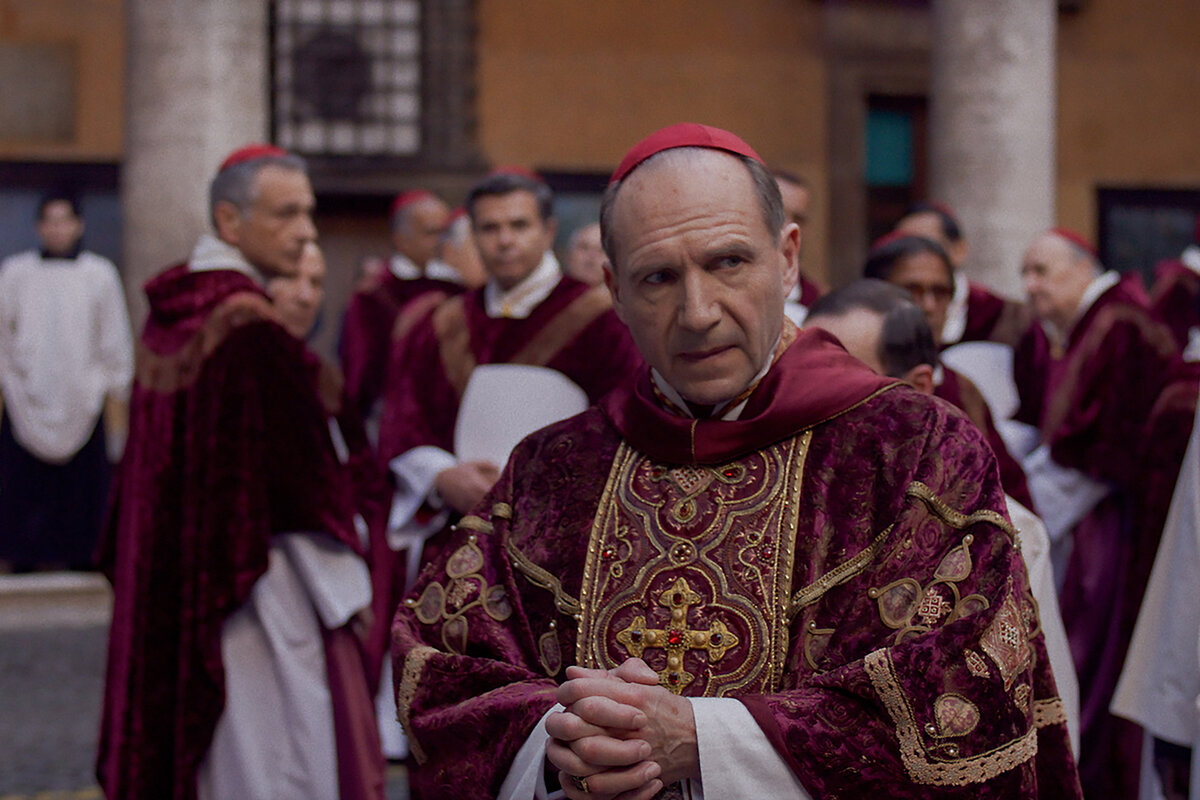
“Conclave,” based on the Robert Harris novel and directed by Edward Berger (“All Quiet on the Western Front”), is a behind-the-scenes Vatican thriller about the election of a new pope. With a cast including John Lithgow, Stanley Tucci, and Ralph Fiennes – particularly good as the cardinal running the sequestered conclave – the film is never less than watchable. The melodrama runs pretty thick, though. And its message is unmissable: As Fiennes’ liberal Cardinal Lawrence states in his homily, “God’s gift to the church is its variety.” (Opens Nov. 1.)
Thom Zimny’s “Road Diary: Bruce Springsteen and the E Street Band” (hitting Hulu and Disney+ on Oct. 25) documents the coming together of the band for its first live shows in six years. There are way too many close-ups of blissed-out fans in stadiums worldwide, but Springsteen, at 74 years old, still puts on a wow of a show. The film places us right at the center of the action. Offstage, Springsteen is candid about how much longer he can continue to go on. A great documentary could be made, I think, about the ways in which still-performing rock ’n’ rollers like Springsteen and the Rolling Stones have transitioned into seniority.
Meantime, if I’m right in believing that filmmakers these days are looking more to unite audiences than to divide them, who is a greater uniter than The Boss?
Peter Rainer is the Monitor’s film critic.
Other headline stories we’re watching
(Get live updates throughout the day.)The Monitor's View
The new kids in the huddle
- Quick Read
- Deep Read ( 3 Min. )
-
By the Monitor's Editorial Board
It’s football season in America, and the girls are taking the field.
They’re playing flag football, that is, a version of the game played without pads or helmets, and with far less physical contact. It is now one of the fastest-growing sports for girls. That growth represents a dramatic turn toward inclusivity in a game that traditionally left girls on the bleachers or on the cheerleading squad.
While flag football doesn’t come with the same physical strength as the contact version, it does add to the range of sports for girls that can boost their confidence and demonstrate the sport ability to nurture character.
Sports in general are a “joyful means of awakening,” wrote author Therese Miller. It also enlightens the “imagination to robust possibilities and convincing realities.” Across a growing number of athletic fields, an artful version of a rough-and-tumble game is widening views for girls as well as for boys.
The new kids in the huddle

It’s football season in America, and the girls are taking the field.
They’re playing flag football, that is, a version of the game played without pads or helmets, and with far less physical contact. It is now one of the fastest-growing sports for girls, sweeping into school athletics programs across the country. It may soon become a Division 1 college sport.
One stat tells it all: The number of girls ages 6 to 17 playing the game doubled during just the last school year, according to the National Federation of State High School Associations.
That growth represents a dramatic turn toward inclusivity in a game that traditionally left girls on the bleachers or on the cheerleading squad. And it brings another benefit: Roughly half of the girls who now play “flag,” as it is known, were not previously involved in school athletics.
While flag football doesn’t come with the same physical strength as the contact version, it does add to the range of sports for girls that can boost their confidence and demonstrate the sport ability to nurture character.
“The football field becomes a classroom for empowerment,” wrote Illiett Ojeda in a blog post for an organization called Miami Mom Collective. “Let’s pause for a moment and imagine our girls weaving through defenders, strategizing, and scoring those winning points. They’re ... breaking barriers, shattering stereotypes, and showcasing their capacity to excel in any arena.”
The game is spreading globally, too. More than 100 countries have organized leagues, according to the International Federation of American Football. Many of them are coed. In 2028, it will make its debut in the Summer Olympics in Los Angeles.
In this version of football, players wear belts with a strip – or flag – on each hip. The one with the ball is “tackled” when an opposing player pulls off one of the ball carrier’s flags. The game has given fathers new ways to connect with their daughters, especially if they are a coach in the sport – as Drew Brees, a former New Orleans Saints quarterback, is for his daughter’s team.
At a time when female athletes like gymnast Simone Biles and professional basketball player Caitlin Clark are drawing historic crowds in women’s sports, flag football is teaching young players new lessons about equality. That’s because this style of play relies less on physical strength and more on mental agility, selfless teamwork, and communication.
“This is the only sport they can truly compete against the boys,” Dallas Sartz, a girls flag football coach in California, told Gold Country Media. Last year, his team of 10-year-old girls stepped “out of their comfort zone” and beat a squad of boys. The result, he said, was a new sense of camaraderie among the players on both teams.
Sports in general are a “joyful means of awakening,” wrote author Therese Miller in a 2008 Sports Journal article. It also enlightens the “imagination to robust possibilities and convincing realities.” Across a growing number of athletic fields, an artful version of a rough-and-tumble game is widening views for girls as well as for boys.

A Christian Science Perspective
Each weekday, the Monitor includes one clearly labeled religious article offering spiritual insight on contemporary issues, including the news. The publication – in its various forms – is produced for anyone who cares about the progress of the human endeavor around the world and seeks news reported with compassion, intelligence, and an essentially constructive lens. For many, that caring has religious roots. For many, it does not. The Monitor has always embraced both audiences. The Monitor is owned by a church – The First Church of Christ, Scientist, in Boston – whose founder was concerned with both the state of the world and the quality of available news.
We don’t have to resign ourselves to anger
- Quick Read
- Read or Listen ( 4 Min. )
-
By Kathryn Jones Dunton
As we accept, with childlike trust, the loving ideas God gives us moment by moment, we can overcome feelings of anger.
We don’t have to resign ourselves to anger
It is sometimes said that generals always fight the last war. Are we sometimes fighting our last war? That is, are we using the template of past experiences to determine our present course of action?
This can be particularly unwise when our previous approach wasn’t constructive. For example, in the past we might have frequently reacted angrily to suspected injustices in our lives.
However, like Christ Jesus’ disciple Peter, we can learn to sheathe our swords of anger and retribution. He learned to do this after “a multitude,” including the servant of the high priest, came to take Jesus away to face the injustice of crucifixion. Peter reacted by cutting off the right ear of the high priest’s servant. But Jesus told him to put away his sword, and healed the man’s ear (see Luke 22:47-51).
At another time, Jesus revealed the spiritual strategy for our warfare with evil of every sort, including anger. He said, “Love your enemies, bless them that curse you, do good to them that hate you, and pray for them which despitefully use you, and persecute you” (Matthew 5:44).
So while feeling anger toward someone acting unjustly might seem like a logical reaction, we can instead learn to love as Jesus did. We can pray to know our oneness with God, the divine Mind. We can pray to understand the situation we are facing, however aggravating it may seem, from God’s loving perspective, knowing that divine Love does not cause or allow us to be subject to injustice. We can pray to have compassion for others and strive to see even those who seem unjust as God sees them, as His precious and wholly spiritual children. And we can forgive.
We always have a choice in how we respond to injustice. We react angrily when we feel that an unjust situation is a reality over which we have no control, but in truth God is in control. As we are willing to let Christ, God’s spiritual idea, change how we see the situation, replacing a perspective of personal emotions with the spiritual view of God’s loving control over all, we will respond in a loving, constructive manner.
It is said that we can’t do the same thing over and over and expect different results. So instead of learning to live with unpleasant character traits, we can increasingly learn to live like Jesus, on the summit of inspiration. Like him, we can turn moment by moment to God, who always reveals fresh ways of approaching the challenges of life.
In “Science and Health with Key to the Scriptures,” Mary Baker Eddy writes, “Willingness to become as a little child and to leave the old for the new, renders thought receptive of the advanced idea” (pp. 323-324). Young children often see situations with fresh eyes. We can be childlike in this way by letting go of preconceived notions or outworn patterns of thought to let in the inspiration of God’s love and wisdom.
I’ve found that studying the Bible and Science and Health shines a light on my thinking and helps me identify and eradicate old ways of thinking and acting that would limit my present success in life. My study and inspired practice of Christian Science has led to much personal progress and growth.
For example, I was raised in a family that at one time expressed a great deal of anger and frustration, which made me question my worth. In reaction to the injustice of my parents’ frequent angry outbursts, I carried anger within myself too, and frequently expressed anger at other perceived injustices.
Through the study of Christian Science, however, I learned over time that we are made in the perfect image and likeness of God, completely worthy and whole. God loves each of us so much that we’re always clothed with the protective armor of divine Love.
As I felt my own worth more deeply, I recognized that it was my responsibility to align my thought moment by moment with divine Love. Instead of feeling angered by others’ lack of respect for me. I realized that as God’s perfect reflection, I could only feel and express what God feels and expresses. This understanding helped me replace feelings of anger and frustration with forgiveness and hope. I had learned a new way to deal with injustice – to express love.
We don’t have to resign ourselves to outgrown, outmoded weapons. Following in the footsteps of Jesus, we learn to use more effective and inspired ways of thinking and acting to triumph over the challenges of life.

Viewfinder
Autumn’s herald

A look ahead
We’re so glad you visited us this week. On Monday, we’ll have a powerful cover story from our Weekly magazine, which examines the rising climate migration crisis. When do changing weather patterns force people to leave their homes? The answer is more complicated than it is often portrayed, and crucial to understand correctly if the world wants to find solutions.


